Orangutan Protection
Orangutans are the largest tree-dwellers on the Earth. Even more than all other primates, they are adapted to a life in the trees. If the rainforest is destroyed, the orangutans lose their primary food source and their natural habitat. BOS protects the orangutans and their home, the rainforest of Borneo.
Asia’s only great apes
You are currently viewing a placeholder content from YouTube. To access the actual content, click the button below. Please note that doing so will share data with third-party providers.
More InformationThe orangutan — “The man of the forest”
In Indonesian, “orang” means person or man and “hutan” means forest — so the orangutan is a “forest man” or “man of the woods”. Like gorillas, chimpanzees, bonobos and we humans, it belongs to the species of the great apes. We humans share 97% of the same DNA with the orangutan. That’s why we are so similar. Just like us, orangutans have feelings, they communicate, play and develop and use tools extremely skillfully. Their fur is orange-red to reddish-brown.
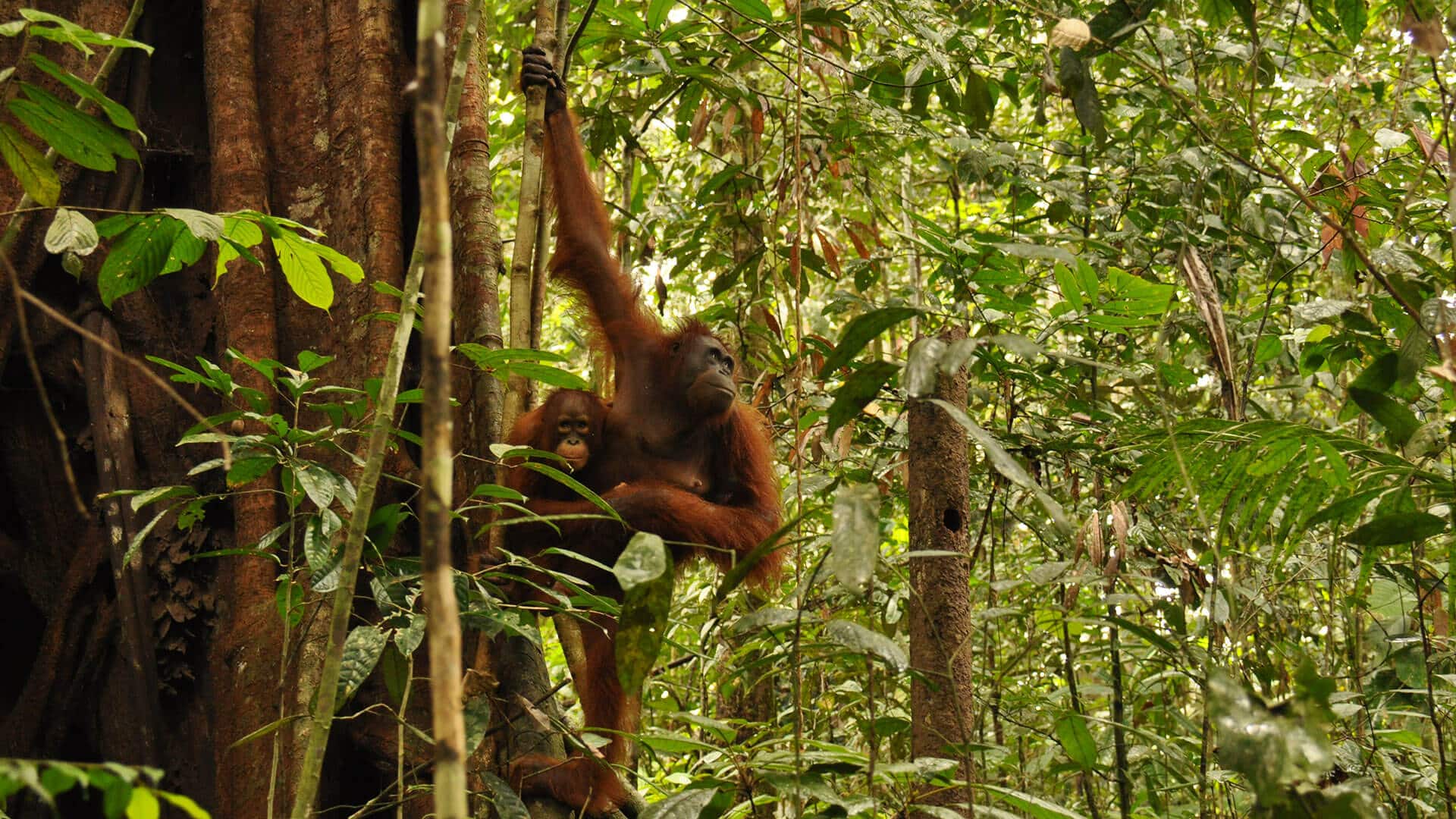
Orangutans Chanel & Charlie in the rainforest
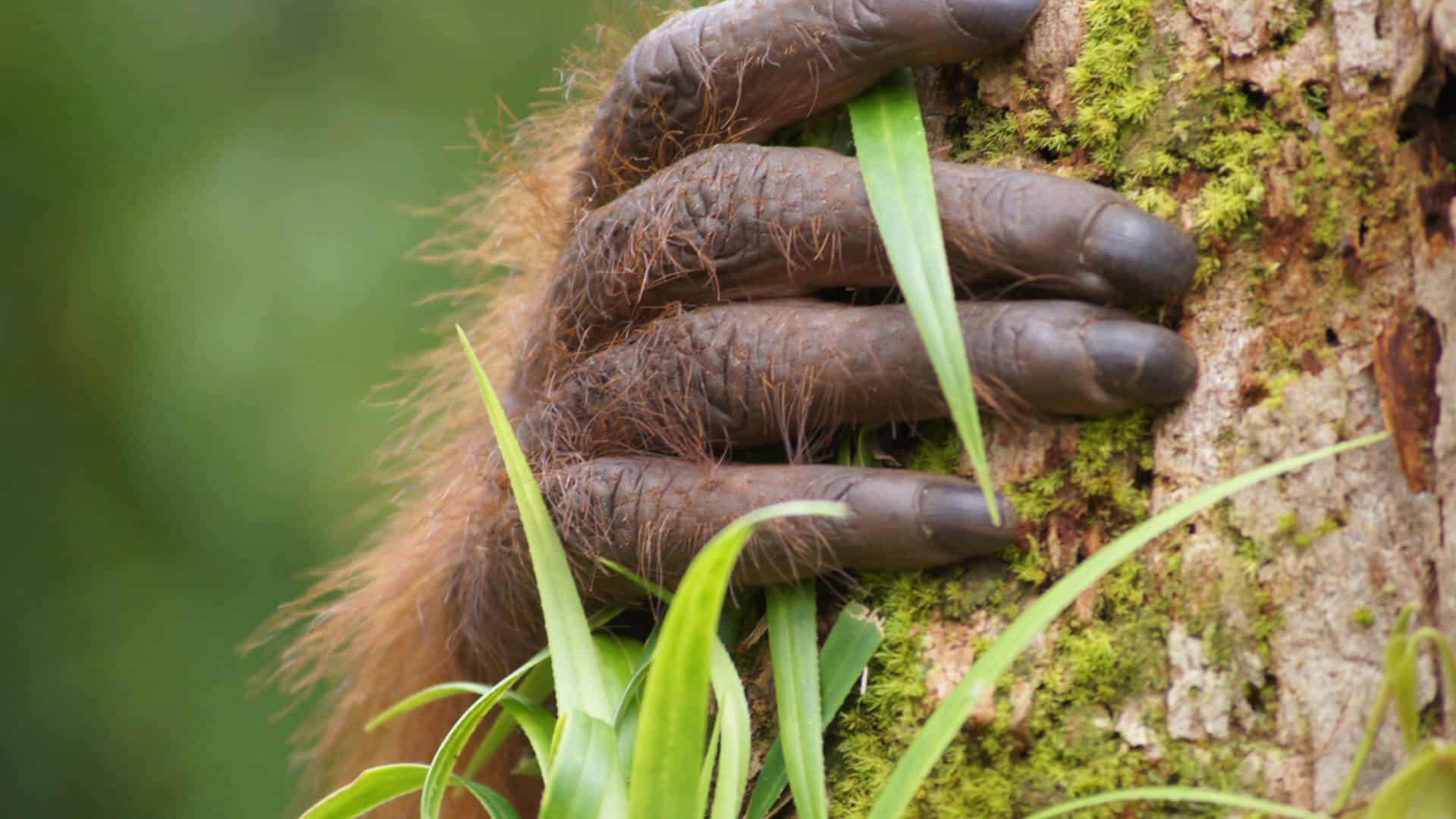
Orangutan hand
They live only in the lowland rainforests on the islands of Borneo and Sumatra in Southeast Asia. A distinction is made between the Bornean orangutan (Pongo Pygmaeus), the Sumatran orangutan (latin: Pongo Abelii) and the Tapanuli orangutan (latin: Pongo Tapanuliensis). All three species are in serious danger of extinction. Only about 57,000 Bornean orangutans, about 14,000 Sumatran orangutans and 800 Tapanuli orangutans still live in their natural habitat.
An adult male can grow up to 1.5 meters tall and weigh up to 120 kg. Females weigh between 30 and 45 kg. The Sumatran orangutan is generally a bit lighter and more petite than its Borneo relative. With an arm span of up to 2.2 meters, long fingers, and a thumb that can grip excellently, orangutans are superbly suited for a life in the treetops. Nevertheless, young orangutans must first learn to climb safely and effectively — just as we humans must learn how to walk.
How do orangutans live?
Orangutans live semi-solitary lives: most of the time they are wandering alone through the forest. Only a mother and her child stay together for up to eight years. Yet on occasion, they also spend time with other members of their species. For example, at popular fruit trees or to play and hang out together.
In the evening, they build a sleeping nest of branches and leaves high up in the trees. Counting such nests, usually used only once, is an important and helpful tool for orangutan monitoring in the wild.
The territory of a dominant male — recognizable by his pronounced cheek bulges — covers the territories of several females. The orangutan male shows his dominance with a call that can be heard from far away, the so-called “long call”.
In the wild, orangutans can achieve an age of 35 to 40 years, but can also grow even older than that. At the age of ten to 15 years, females become mothers for the first time. Mother and child stay together for six to eight years. During this time, the offspring learns what they need to know to survive in the rainforest: safe climbing, finding the right food and building sleeping nests are just as much a part of this as forming social bonds with their fellow orangutans and also which dangers to avoid in the jungle.
What are orangutans threatened by?
Today, the population of Bornean orangutans is estimated at about 57,000 animals. Compared to the population in the year 1973 of 288,500 orangutans, this means a decline of 80% in less than 50 years.
The greatest threat to orangutans is the destruction of their natural habitat.
In the 1980s, about 75% of Borneo’s was still covered by pristine forest. Today, barely around 50% remains.
Palm oil plantations and coal mining are the greatest drivers of rainforest destruction. But also the pulp and paper industry and the trade with tropical woods lead to massive deforestation and destroy the rainforest. Oil palm plantations cover at least 14 million hectares in Indonesia. There are plans to expand the area under palm oil cultivation to 20 million hectares.
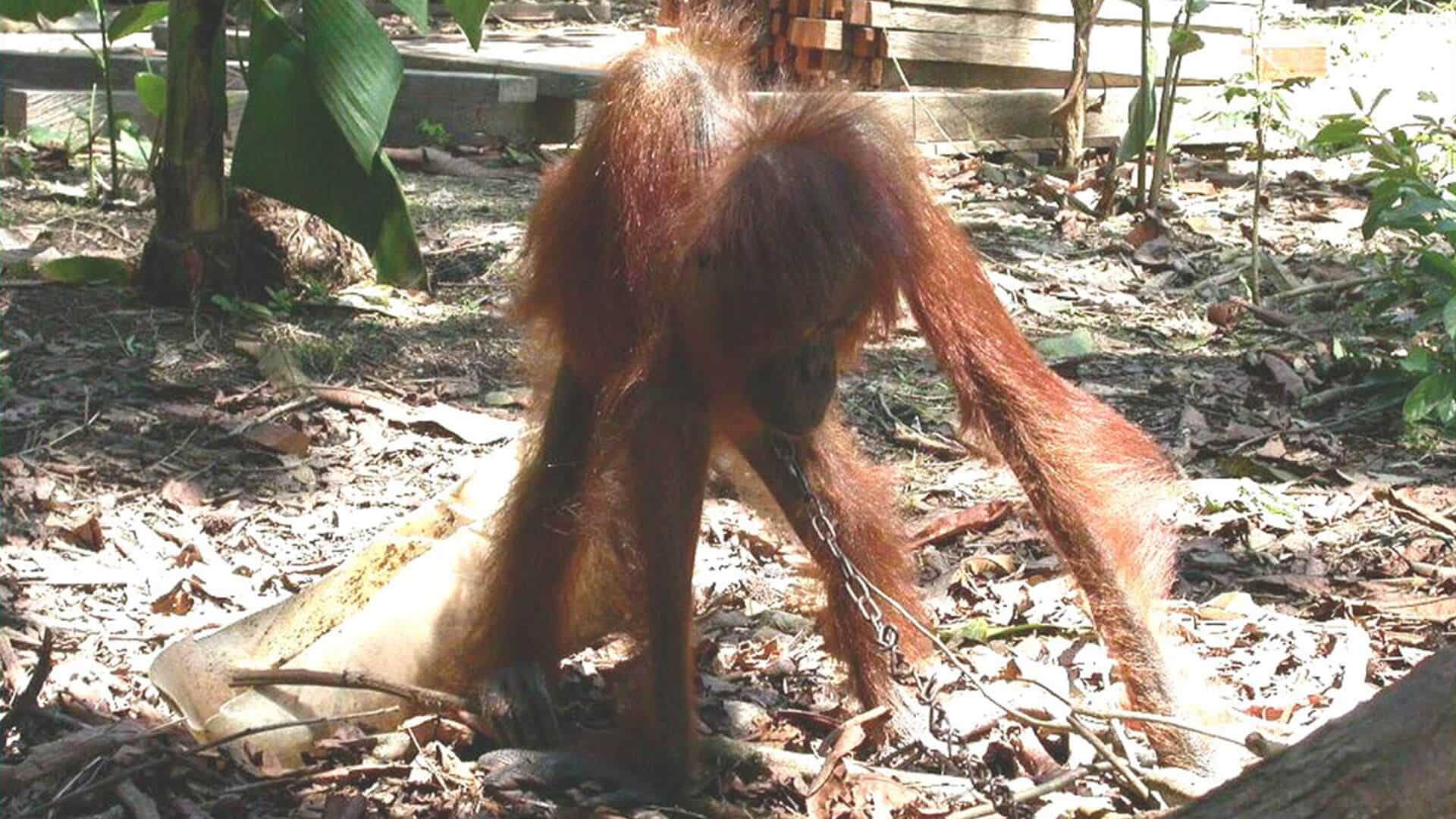
Starving orangutans are often forced to wander into plantations
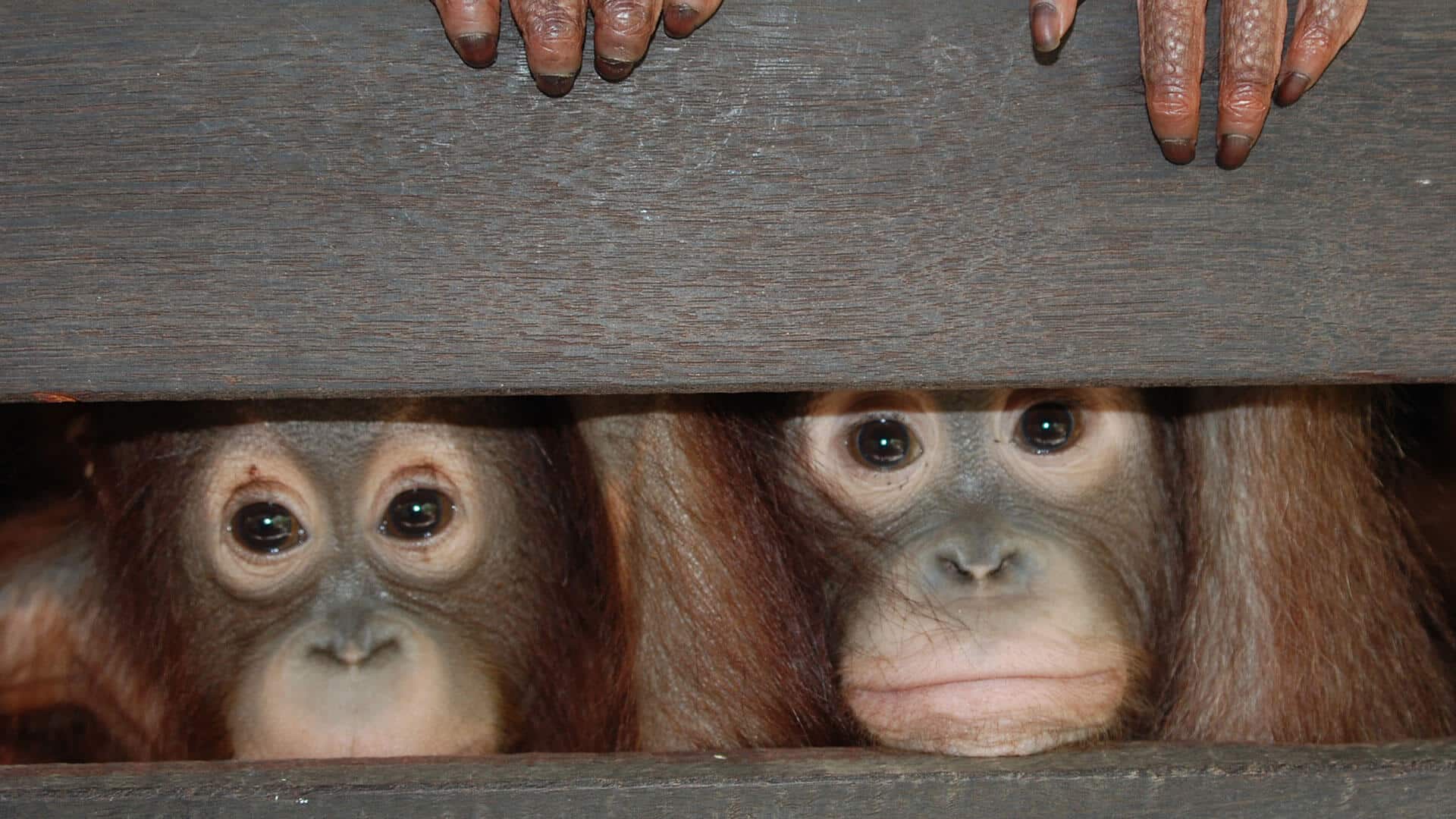
Orangutan babies are held illegally in a cage
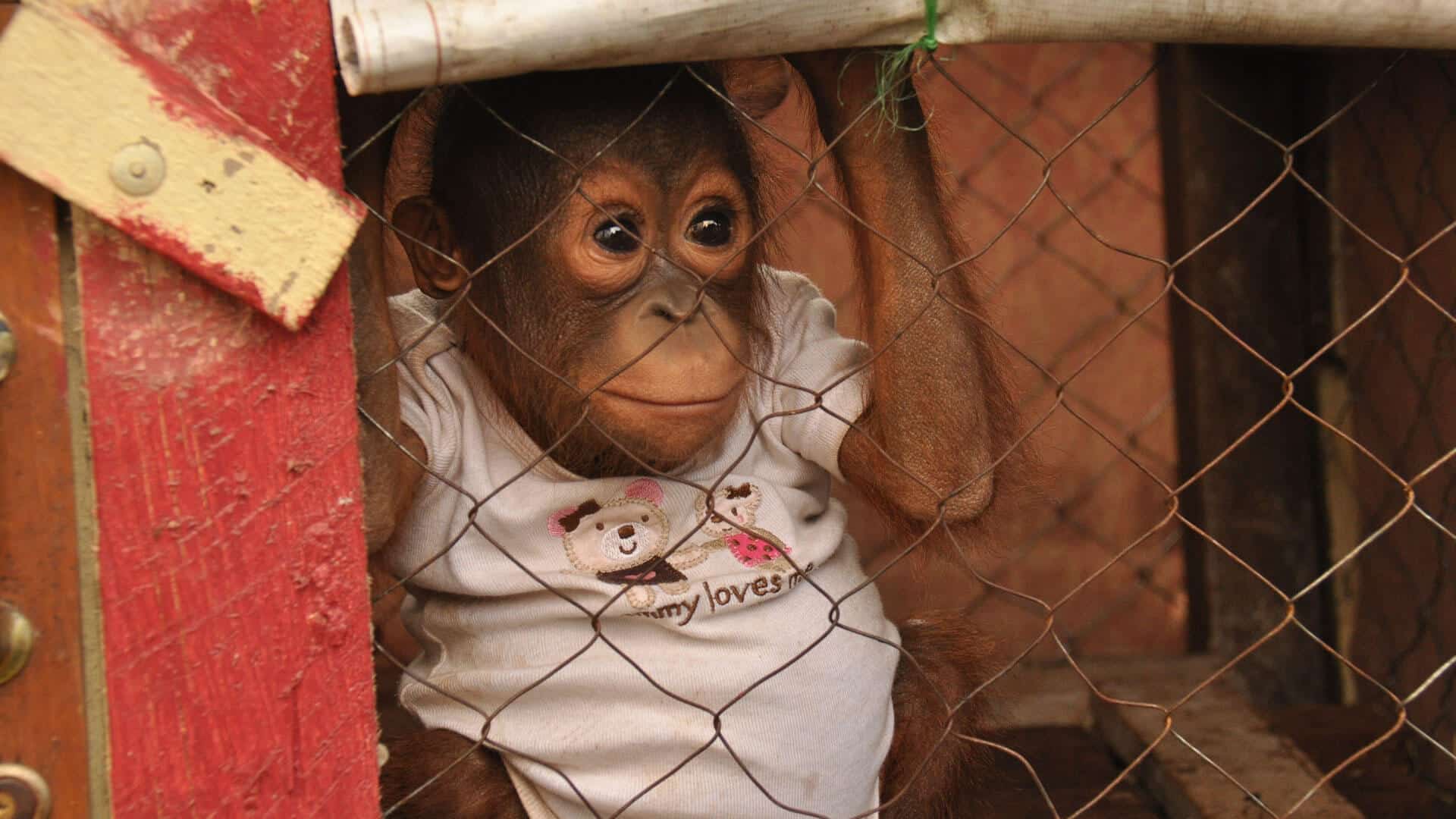
Orangutan baby short before it has been rescued by BKSDA and BOSF team
Additionally, the expansion of human settlements and cities, seasonal forest fires and the effects of climate change are leading to the destruction of forest areas.
As a result, the habitat for orangutans is becoming increasingly scarce. This leads to more and more conflicts between humans and animals when orangutans come to gardens or plantations in search of food. In many cases, this ends deadly for the orangutan. All too often, baby orangutans become orphans and victims of the illegal wildlife trade.
Orangutan conservation and protection
BOS supports the Indonesian conservation authority BKSDA in rescuing orangutans from illegal pet farming, palm oil plantations or other emergencies. In two BOS rescue centers on Borneo, the injured, sick and orphaned orangutans are taken in and given medical care by veterinarians in our clinics. Our “babysitters” take care of the often severely traumatized orphans.
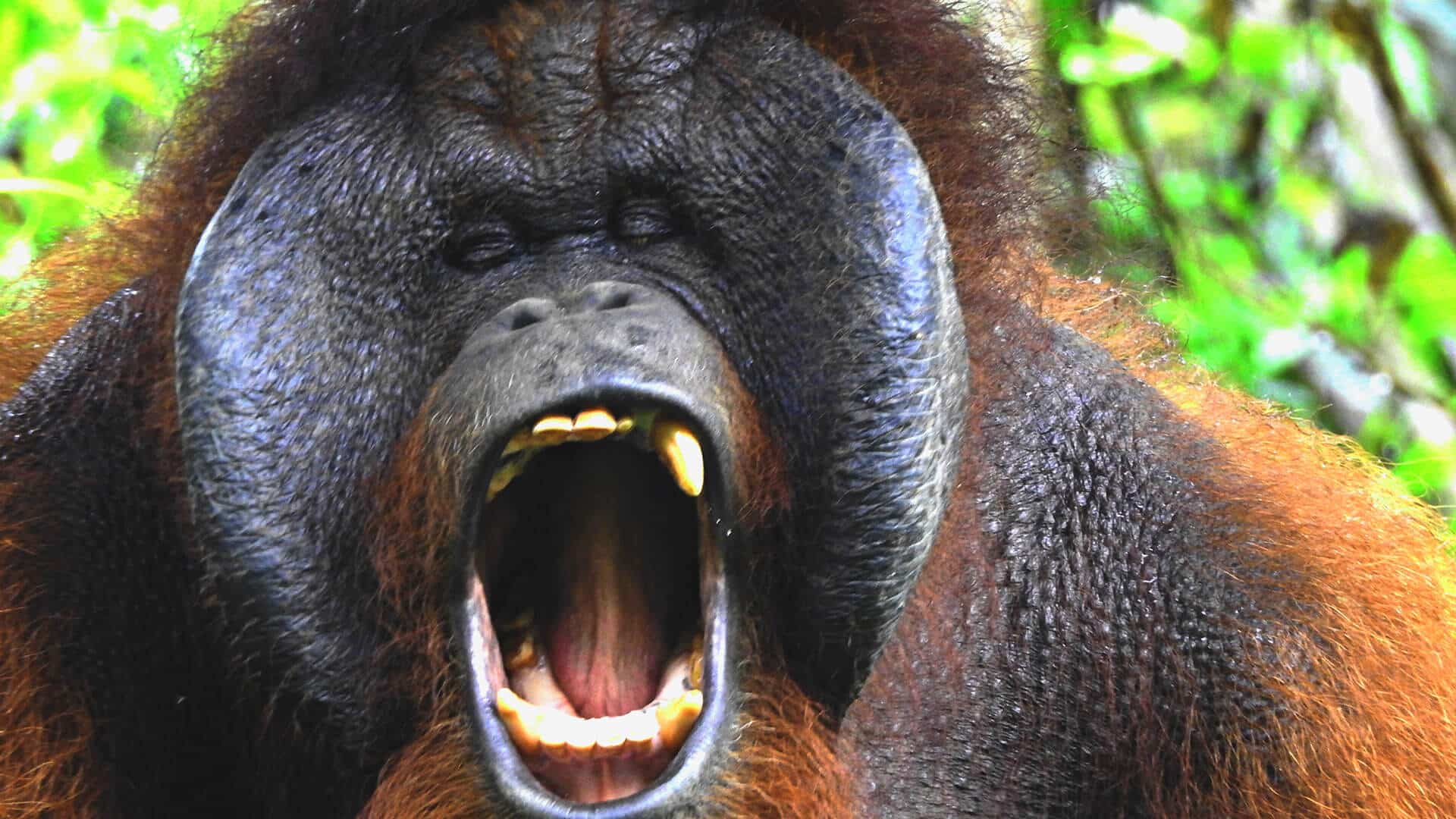
Some male orangutans develop fatty tissue on both sides of their face — known as flanges
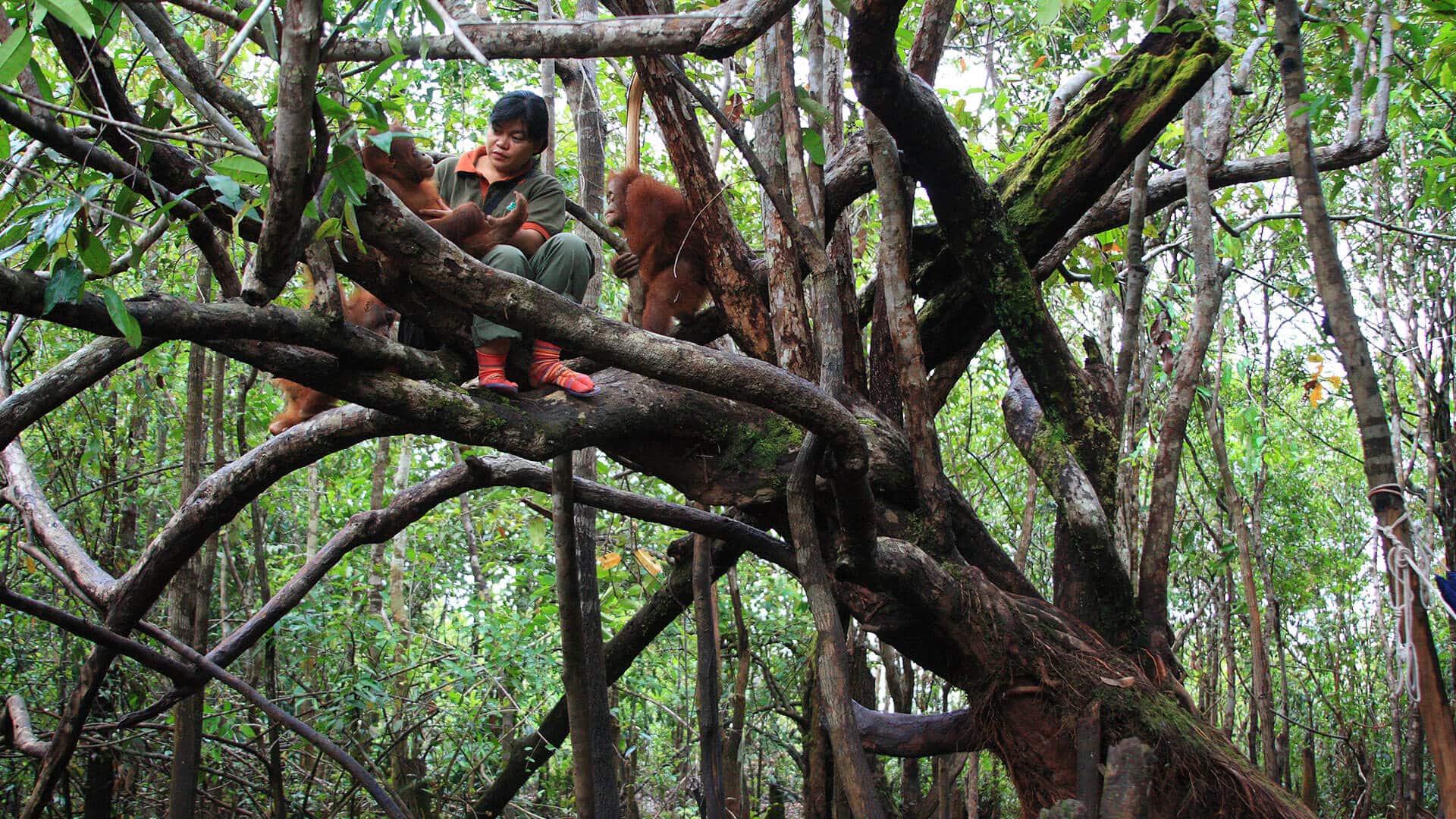
Babysitters are training young orangutans in the forest school.
Orangutan Rehabilitation
When an orangutan enters one of BOSF rehabilitation centers, they are immediately assessed and treated by our team of veterinarians then quarantined before being placed into the appropriate stage of the rehabilitation process. The youngest orangutans join the nursery group while the juveniles are placed in a forest school. On their journey through forest school, the young orphans are taught the skills they need to survive in the wild, all while they are stimulated to express natural behaviours. The training of the orangutan offspring lasts up to eight years. Finally, they have to prove themselves on one of our pre-release islands — the Forest University. Only then, they are considered as well-prepared for release into the wild.
Orangutan Reintroduction
If an orangutan is healthy and able to survive on its own in the wild, it is released as soon as possible. For this purpose, BOS has acquired concessions for protected areas where the orangutans can live safely and in freedom.
Rescue centers & Forest schools
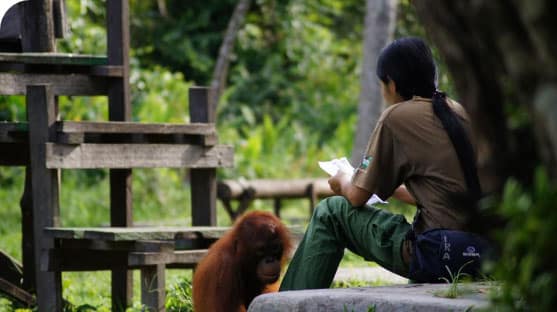
Rescue centers
In Borneo, BOS cares for more than 400 orangutans rescued from emergency situations in two rescue centers. Here they are prepared for an independent life in freedom.

Forest schools
The young orphaned orangutans attend forest school every day at the rescue centers. Here they learn everything they need to know, in order to survive in the rainforest.
Release & Monitoring

Release
Since 2012, BOS has been releasing rehabilitated orangutans into three protected rainforest areas. Nearly 500 forest people have already been able to start their new wild lives in Kehje Sewen, Bukit Batikap and Bukit Baka Bukit Raya.
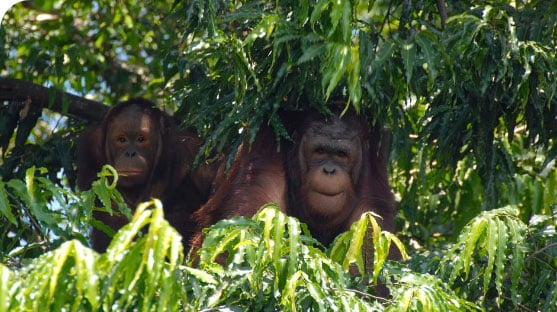
Monitoring
We do not abandon the orangutans after their release. Monitoring teams are constantly on the move in the remote rehabilitation forests and keep an eye on the new wild animals.
Make a donation for the orangutans
Make a one-time donation
Orangutans need our help! With your donation for the orangutans you accompany and support an orangutan on its journey until its release into the wild.
Frequently Asked Questions
Where does the orangutan live?
Your Subtitle Goes Here
A distinction is made between the Bornean orangutan (latin:Pongo Pygmaeus), the Sumatran orangutan (Latin:Pongo Abelii) and the Tapanuli orangutan (Latin: Pongo Tapanuliensis). The Bornean orangutan lives on the island of Borneo in the Malay Archipelago.
In Borneo, the species is divided into three genetically distinct subspecies: Pongo Pygmaeus Morio in East Kalimantan, Indonesia and Sabah, Malaysia; Pongo Pygmaeus in West Kalimantan, Indonesia and Sarawak, Malaysia; and Pongo Pygmaeus Wurmbii in Central and West Kalimantan, Indonesia. While the orangutan was once widespread on the island, the species’ range is now limited and fragmented into an estimated 42 populations.
Their range is naturally limited by altitude, as orangutans generally live below 500 m above sea level. Today’s population fragmentation of orangutans is not due to normal elevation limitations, but rather to the impact actions of humans have had. Humans have encroached on many of the orangutan’s natural habitats, completely deforesting or destroying the habitats, which also affects the overall health of the ecosystems.
Orangutans are found in a variety of habitats, from brackish mangrove forests to limestone forests, but they most commonly live in what are known as tropical lowland forests. However, this term encompasses a variety of different forest types, of which the two most important for orangutans are dry Dipterocarpaceae forests and swamp forests.
Dipterocarpaceae forests are what most people imagine when they think of the “jungles of Borneo.” The predominant tree species in the forests are from the Dipterocarpaceae family (winged fruit family). This large tree family also includes giant trees such as Meranti and Kapur. While winged fruit plants form the heart of the ecosystem — and are an integral part of the orangutan’s diet — the forests are also full of other species, including ironwood trees, fruit trees, carnivorous plants, countless beetles, fish, birds and thousands of other animal species, from clouded leopards and pythons to shy pangolins and pit vipers.
Borneo’s orangutans may also live in swamp and peat swamp forests. Although these peat swamp forests are not as species-rich as Dipterocarpaceae forests, they are still an important habitat for the Bornean orangutan. Peat swamp forests are home to countless specific endangered plant and animal species and play a key role in the global carbon and hydrologic cycles.
Every orangutan forest is teeming with creatures that may not be as “charismatic” as orangutans, but are just as important to our global ecosystem. That’s why we need to protect orangutans, their neighbors, and their natural habitat. Because orangutan protection means rainforest protection and equals climate protection.
How do orangutans spend the day?
Your Subtitle Goes Here
Orangutans spend up to 60% of their time awake searching for and eating food. Depending on the season and location, this can be an easy or more difficult task. About ten percent of their day is spent wandering through the jungle, often in search of new food sources. The remaining 30% of their time is spent in a variety of activities, from resting and cleaning to playing and other social activities.
What do orangutans eat?
Your Subtitle Goes Here
Orangutans are considered omnivores, meaning they eat both plant and animal foods, but the majority of their diet consists of plants. Orangutans have an extremely broad diet. More than 2,000 different plant species are part of their diet. Fruits are their favorite, but they also eat leaf shoots, leaves, bark, flowers, mushrooms, the pith of branches, insects, honey, and occasionally eggs. There are rare reports of orangutans even eating small mammals.
Do orangutans have enemies?
Your Subtitle Goes Here
Yes, the most dangerous one is the human! Other predators that can be dangerous to them are the clouded leopard, Sumatran tiger, crocodiles and snakes.
Why is the orangutan threatened with extinction?
Your Subtitle Goes Here
First, because we are destroying its home, the rainforest! Second, they reproduce very slowly, because in the wild a female usually gives birth to a baby only every eight years. Third, people hunt orangutans to capture young animals for the illegal wildlife trade.
How can I protect orangutans?
Your Subtitle Goes Here
Avoid non-sustainably certified palm oil. Pay attention to the ingredient list when buying food. Palm oil or palm fat is found in many supermarket products: in ready meals, sweets, margarine, bread spreads, candles, cosmetics, cleaning products and detergents. Around 85% of palm oil comes from Indonesia and Malaysia. Also approach your local retailers and manufacturers about buying only products from certified palm oil cultivation. The demand still determines the supply.
Most palm oil imported into the EU ends up in biodiesel. So not driving helps the orangutans, too.
Use only recycled paper. Only buy coloring books, exercise books, toilet paper and other paper products made from 100% recycled paper (recognizable by the “Blue Angel” seal). Because no rainforest has to be cleared for it.
Do not buy tropical wood. When buying furniture, picture frames and other products made of wood always ask where the wood comes from. If the annual rings are missing, it may be tropical wood.
Where are rescued orangutans being sheltered?
Your Subtitle Goes Here
Rescued orangutans are handed over by the Indonesian Nature Conservation Authority (BKSDA) to organizations such as Borneo Orangutan Survival Foundation or International Animal Rescue, which then take over the rehabilitation process for the rescued animals.
Who protects orangutans?
Your Subtitle Goes Here
The orangutan is protected under Indonesian law, and the Indonesian state is responsible for enforcing this law. Other important parties are the Indonesian Nature Conservation Authority (BKSDA), non-governmental orangutan conservation organizations and all supporters around the world who make the rescue, rehabilitation, reintroduction and monitoring work possible with their donations.
How are the orangutans protected after they are released into the wild?
Your Subtitle Goes Here
BOS releases orangutans into safe sanctuaries and national parks. Each orangutan is implanted with a transponder prior to release, which can be used to track them during their first few months in the rainforest. Our post-monitoring teams are constantly touring the reintroduction areas and monitoring the “New Wild Ones”. However, it sometimes happens that animals leave the reintroduction forests and thus the protected rainforest areas. BOS conducts education campaigns among the local population to raise awareness about the importance and protected status of orangutans. In addition, we provide some options for action when conflicts arise between orangutans and humans — for example, because in search of food, the animals enter areas managed by humans. Sometimes our teams have to work with the Indonesian Nature Conservation Authority (BKSDA) to relocate orangutans in order to minimize such conflicts (mainly involving animals not released by us).
Will the wild orangutan population grow again?
Your Subtitle Goes Here
That is the main goal of our work. However, it is not an easy task. Female orangutans can only become pregnant about every eight years. Therefore, it is essential that no animals are killed and that the wild animals retain their habitat.